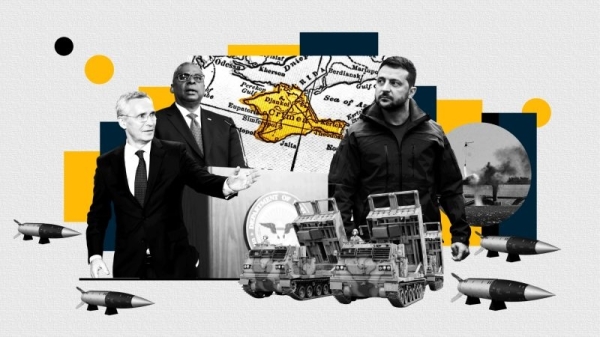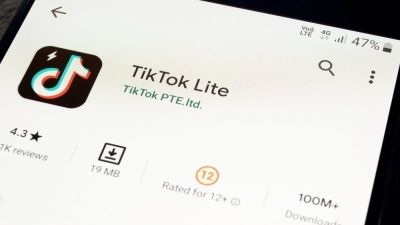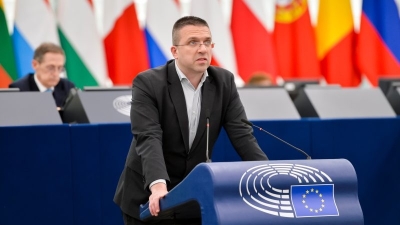How the West’s position on Ukraine taking back Crimea could turn the war

Retaking control of the Russian-seized Ukrainian territory of Crimea, which Kyiv says it needs to retake to end the war, could soon become a point of divergence between Kyiv and its Western allies.
“It began with Crimea, it will end with Crimea,” Ukraine’s President Volodymyr Zelenskyy said last August, quoting jailed Crimean activist Nariman Dzhelyal.
The Black Sea peninsula, seized by Russia in 2014, hosts several important Russian military bases, and was one of the launchpads for what Moscow called its “special military operation”.
Holding Crimea as well as the seized land bridge from Zaporizhzhia enables the Russian military to threaten Ukrainian positions from the south and gives Russia’s Black Sea Fleet a forward base in Sevastopol for carrying out long-range attacks.
Kyiv has repeatedly emphasised the need to retake the peninsula, affirming it will not abandon efforts to regain control of the region along with the swath of eastern Ukraine and other territories that Moscow’s forces have seized since 24 February.
Since the start of the invasion, the region has come under attack several times – most spectacularly last summer when a series of explosions destroyed a group of warplanes at a Russian naval base.
In recent months, Ukrainian forces have been pushing a counter-offensive in the south towards Crimea and reclaimed Kherson, the capital of the southern territory bordering the annexed peninsula.
With the help of newly promised Western tanks and other Western-made weapons, Ukraine’s armed forces are likely to liberate more territory in the east and south of the country – raising the possibility of an eventual Ukrainian campaign to retake Crimea.
However, Kyiv is missing one thing to achieve the strategic goal: Western-made long-range missiles that are able to shoot 150-300 kilometres directly at the target.
“Crimea is our land, our territory,” Zelenskyy said told the World Economic Forum in Davos last month. “Give us your weapons,” he urged, and Ukraine will retake “what is ours”.
Ukrainian military officials this week warned on the one-year anniversary of the war that Russia is swiftly working to bolster its defence of the Crimean Peninsula.
‘Crimea first’
But is it possible for Ukraine to reclaim Crimea?
“Ukraine has to take Crimea first, this year, before the Donbas,” former commander of US troops in Europe, General Ben Hodges, told EURACTIV, sitting in a Munich cafe holding a strategic map of the country.
“As long as Russia is able to launch planes of rockets, drones out there, or the Black Sea Fleet is able to operate from here, the country will never be safe or secure, or be able to rebuild their economy,” Hodges said.
With the looming threat from Russia’s Black Sea Fleet in Crimea, Ukraine will not be able to use the ports in Mariupol and Odesa.
Contrary to what some sceptical policymakers and analysts say, Hodges believes a Ukrainian military campaign to liberate Crimea is not out of the question.
Provided Western allies would provide all the necessary weapons, primarily long-range missiles, Kyiv could liberate the Black Sea peninsula by the end of summer, he said.
“If you want to accomplish the isolation and then the liberation of Crimea, you need the capability to isolate it – disrupt the main communications between Russia and Crimea, the Kerch bridge and the landbridge – with long-range missiles air strikes on the bridges and ground strikes by a large armoured force,” Hodges said.
According to the general, Ukraine has done well protecting information about its own capabilities and mixed together with equipment pledged by Western allies, it would be enough for such an endeavour.
“If we assume it’s at least three months before the conditions are right – weather, ground and Russians exhausted – that’s three more months to train and practice,” Hodges said.
Western hesitation
The issue, however, has been increasingly posing a dilemma for Western policymakers, despite public assurances of Crimea’s territorial integrity.
Many fear that in a Russian roulette scenario, Putin’s defeat, and especially the liberation of Crimea, may constitute a ‘red line’ and very well prompt him to use nuclear weapons.
Several European NATO members have been cautious on the issue, with Western Europeans, in particular, sceptical of what can realistically be achieved on the battlefield.
They have been wary of going into details about what Ukrainian victory would entail in practice, with many NATO diplomats unwilling to go on record whether Crimea would be included in such plans.
Earlier this year, Zelenskyy said Ukraine needed US-made ATACMS missiles, which have a range of roughly 297 kilometres. Washington has so far declined to provide the weapon.
The list of ATACMS users includes South Korea, Poland, Romania, Greece, Turkey, Qatar and Bahrain.
Asked by EURACTIV about Crimea and the possibility of longer-range missiles supplied to Kyiv, NATO’s Secretary General Jens Stoltenberg declined to go into military-operational issues.
While he cautiously pointed to the fact that “support has evolved as the war has evolved”, he stressed that the West’s “responsibility is to is to ensure left Ukraine is capable of defending their own territory – and that’s what we’re doing”.
“Wars are by nature unpredictable, but of course, this war may end at the negotiating table. What we do know is that what happens around that negotiating table is totally dependent on the strength of the battlefield,” he added.
Turning tides
Washington until recently has maintained strategic ambiguity on the issue, with US Secretary of State Anthony Blinken stating that the goal was merely to give Kyiv the means to “take back territory that has been seized from it since February 24”, not what Russia seized already in 2014.
But the tide seems to be turning across the Atlantic.
“The United States does not and never will recognize Russia’s purported annexation of the peninsula – Crimea is Ukraine,” the US State Department said in a statement on Sunday (26 February).
“Ukraine is not going to be safe unless Crimea is, at a minimum, demilitarized,” US State Department Undersecretary Victoria Nuland told the Carnegie Endowment for International Peace last week.
“There are command-and-control sites in Crimea that are essential for Russia’s hold on all of the [occupied Ukrainian] territory, including the land bridge,” she said.
“There are mass military installations in Crimea that Russia has turned into essential logistics and back-office depots for this war – those are legitimate targets,” she added.



